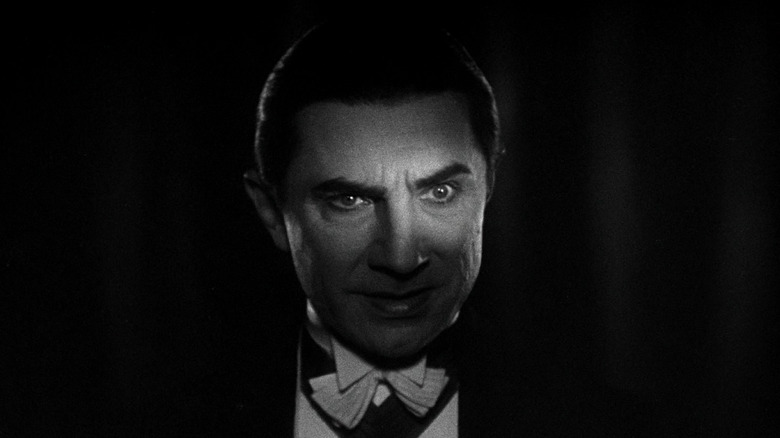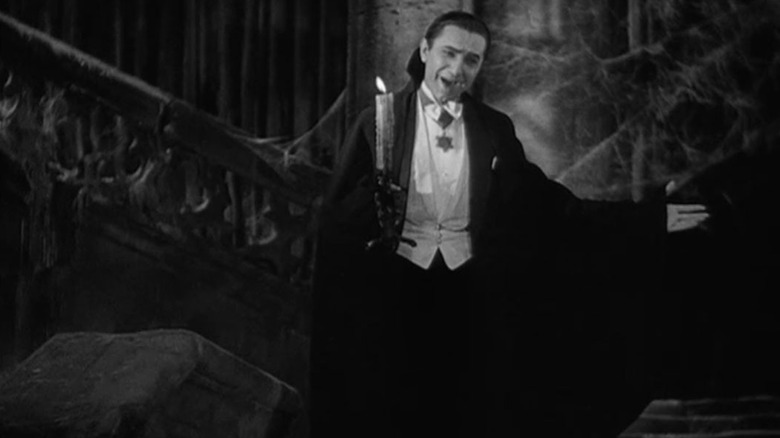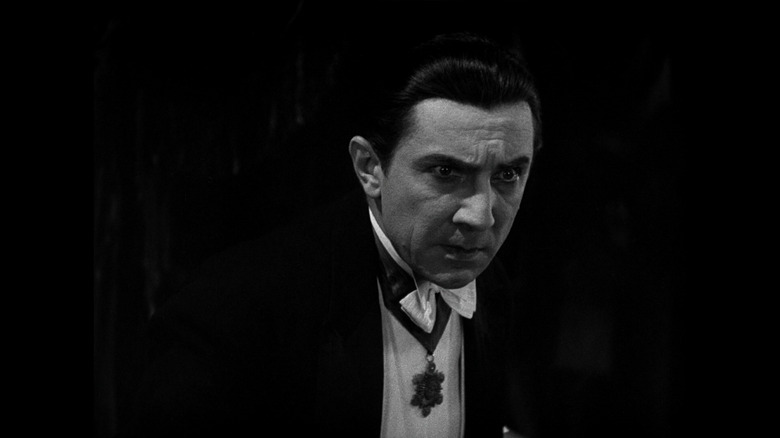Bela Lugosi Thought This Was The Key To Successful Horror Acting
Bela Lugosi never sought to be a horror actor, but Hollywood in the 1930s wasn't kind. Lugosi began acting professionally at the age of 20, appearing in several traveling operetta productions in his native Hungary. After a stint in the army, Lugosi began a career in film acting in the 1910s under the stage name Arisztid Olt, one of the cooler stage names one might encounter, and most assuredly the name of a Goth band somewhere in the world. Lugosi eventually fled Hungary, acted in Germany for a spell, then wound up taking a ship to the United States where he would land the role of a lifetime, playing Count Dracula in a celebrated stage adaptation of Bram Stoker's famous novel.
While touring with "Dracula," he caught the attention of Universal talent scouts, and he was to be cast in Tod Browning's 1931 film adaptation of the play/novel (it's sort of a mix). The rest is history. Bela Lugosi officially taught the world how vampires look and behave. No one has played a more impressive Dracula since.
Lugosi's Hungarian accent, however, and association with horror movies left him typecast as creatures and mad scientists. Part of him did enjoy the role of Dracula, but part of him resented it. This arc of Lugosi's career is detailed in the 2010 biography "The Immortal Count: The Life and Films of Bela Lugosi" by Arthur Lenning. The same book also featured a 1935 interview with the legendary actor as to his ethos when it came to acting. He didn't believe in vampires or monsters himself, but when playing Dracula, well, he had to believe in himself.
Practicing in the mirror
In "The Immortal Count," Lenning wanted to explode a popular misrepresentation of Lugosi's habit of getting into character. Certain journalists at the time describe Lugosi's practice of standing in front of a mirror in full costume, repeating the phrase "I am Dracula" with different intonations. The myth was that Lugosi shouted that line as if to insist to himself that he was indeed Dracula. This gave rise to rumors that Lugosi had taken his Stanislavski reading too seriously, and that he was "one of those" method adherents that were a pain to work with.
In truth, Lugosi did not shout the line but was merely rehearsing it.
In 1935, Lugosi expanded on the practice. He was indeed using the "I am Dracula" ritual to get into character, but it was more to put himself in the headspace of a vampire. The actor knew that Count Dracula was a wild, broad fantasy creature, but Dracula himself certainly didn't think so. Lugosi said:
"Whether one thinks of films like 'Dracula' as 'hokum' or not does not alter the fact; the horror actor must believe in his part. [...] I am not saying that I personally take seriously these vampires and monsters as such. I am saying that one must take them seriously when one is portraying. In playing Dracula, I have to work myself up into believing that he is real, to ascribe to myself the motives and emotions that such a character would feel. For a time I become Dracula — not merely an actor playing at being a vampire."
Bringing dignity
With that statement, Lugosi was attempting a very ambitious task: to bring a great deal of dignity to horror.
Horror actors, it seems, were getting a bum rap in Hollywood, and Lugosi wanted to state explicitly that playing Dracula was a "proper" acting job. Horror actors aren't mere ghouls with an easy gig, but real professionals who take their characters — fantastical or not — as seriously as any dramatic actor. Lugosi didn't want to take a role that didn't challenge him. Indeed, the legend goes that, after the success of "Dracula," Universal head Carl Laemmle, Jr. approached Lugosi about the possibility of playing the undead monster in an adaptation of Mary Shelley's "Frankenstein." Lugosi refused, feeling that Frankenstein's monster, in having no speaking lines, could have been played by just about anyone.
The role ended up going to British actor Boris Karloff, and the two have been associated with horror ever since. Although he resented being typecast as Dracula in other monster roles, Lugosi's face, or a rendition of it, still graces lunchboxes and Halloween costumes to this day. Almost every screen vampire, and certainly every screen Dracula, could be seen as a derivation of Lugosi's performance. Lugosi could have been known for much more, had Hollywood given him the chance, but his most famous role is certainly one of the most memorable in cinema history.
Lugosi continued to act until his death in 1956. Many studios refused to hire him after he became addicted to doctor-prescribed pain medicine for his sciatica. His final film roles were dramatized in Tim Burton's 1994 film "Ed Wood," the eponymous director of "Plan 9 from Outer Space." Martin Landau won an Academy Award for playing Lugosi. It seems that his legacy lives on.


